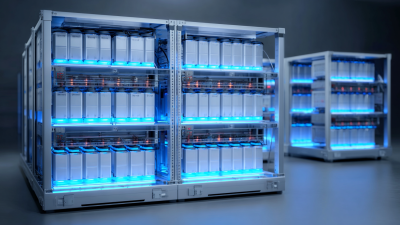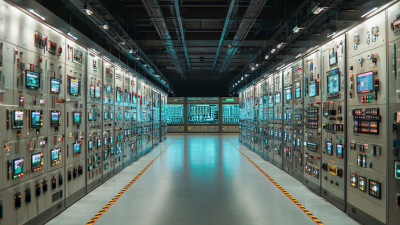The landscape of electrical supply systems is undergoing a significant transformation driven by innovative technologies and a growing emphasis on sustainability. According to the International Energy Agency (IEA), global electricity demand is expected to increase by 50% by 2030, necessitating improvements and advancements in electrical supply systems to meet this demand efficiently. Renewable energy sources, such as solar and wind, are projected to account for nearly 70% of new power generation capacity globally by 2050, highlighting the need for modernized infrastructure that can handle this shift. Moreover, a report from the World Economic Forum indicates that investments in smart grid technologies are projected to exceed $800 billion by 2023, underscoring the critical role of innovation in ensuring reliable, resilient, and sustainable electrical supply systems for the future. As we delve into the evolving dynamics of these systems, it is essential to explore the trends and technologies that are shaping a sustainable energy landscape.

The emerging technologies revolutionizing electrical supply systems play a vital role in creating a sustainable future. As demands for cleaner energy sources grow, innovations in infrastructure are being prioritized to alleviate the energy crisis associated with AI expansion. The integration of AI into energy systems is not only improving efficiency but also reducing emissions, making it a key component in the global shift towards sustainability. Organizations are leveraging smart strategies that combine cloud computing and AI to develop more effective energy solutions across various sectors, including agriculture.
In particular, researchers are focused on pioneering advanced materials and processes that enhance energy efficiency, ensuring that future power systems can meet increasing demand without compromising environmental targets. The collaboration between technology and sustainability is becoming increasingly important as companies seek to embrace greener practices while optimizing operational efficiency. By rethinking traditional energy supply models and integrating innovative technologies, the future of electrical supply systems can support a more sustainable, empowered society.
This chart illustrates the projected investments in various emerging technologies for electrical supply systems, emphasizing the importance of sustainability and innovation in building a robust future for energy systems.
The smart grid is transforming the energy landscape by enhancing energy efficiency and reliability, which is crucial in a world increasingly focused on sustainability. According to recent market analysis, the global smart grid market is expected to grow from $49.21 billion in 2024 to $203.92 billion by 2032, with a remarkable compound annual growth rate (CAGR) of 19.45%. This reflects a significant shift towards innovative energy management solutions that integrate renewable sources, such as solar energy and storage systems.
Tip: Embracing smart grid technologies can not only reduce operational costs but also improve reliability in energy supply. As governments establish ambitious goals for new energy storage capacities over the next few years, businesses and consumers alike should consider how to adapt to these advancements.
The implementation of smart grids enables real-time communication between various components of the electrical supply system, facilitating better demand response and energy distribution. The recent initiative from the National Development and Reform Commission and the National Energy Administration in China highlights the commitment to advancing modern energy storage solutions from 2025 to 2027, setting the stage for scalable and efficient energy management practices worldwide.
Tip: Stay informed about local regulations and incentives related to smart grid technologies; leveraging these can enhance your energy strategy and promote sustainability within your community.
The integration of renewable energy sources into electrical supply systems is a pivotal trend in the pursuit of sustainable energy solutions. According to the International Energy Agency (IEA), renewable energy accounted for nearly 30% of the global electricity generation in 2021, with expectations to rise significantly as countries commit to reducing greenhouse gas emissions. Solar and wind energy are leading this transformation, with global solar capacity alone anticipated to reach 2,000 GW by 2025, driven by technological advancements and decreasing costs.
However, the transition to renewable sources presents several challenges. A report by the World Economic Forum highlights that while the share of renewables is growing, grid integration remains a critical hurdle, requiring substantial investment in infrastructure that can accommodate fluctuations in energy supply. Additionally, improving energy storage solutions is essential for managing intermittency in renewable generation, as highlighted by a recent study from BloombergNEF, predicting that the energy storage market will surpass $620 billion by 2040. As we navigate this complex landscape, industry stakeholders must collaborate to harness innovations that ensure a stable and sustainable electrical supply.
 Innovative energy storage solutions are emerging as critical components in ensuring the stability of modern electrical supply systems. According to a report by the International Energy Agency (IEA), global deployments of battery storage systems are expected to exceed 400 gigawatt-hours (GWh) by 2030, a dramatic increase from just 15 GWh in 2020. This surge is primarily driven by the need for flexibility in energy supply, as renewable energy sources like solar and wind become more prevalent. Effective energy storage enables grid operators to balance supply and demand, thus enhancing reliability and reducing the risk of outages.
Innovative energy storage solutions are emerging as critical components in ensuring the stability of modern electrical supply systems. According to a report by the International Energy Agency (IEA), global deployments of battery storage systems are expected to exceed 400 gigawatt-hours (GWh) by 2030, a dramatic increase from just 15 GWh in 2020. This surge is primarily driven by the need for flexibility in energy supply, as renewable energy sources like solar and wind become more prevalent. Effective energy storage enables grid operators to balance supply and demand, thus enhancing reliability and reducing the risk of outages.
Moreover, advancements in technology are making energy storage more efficient and accessible. The U.S. Department of Energy's 2022 Energy Storage Market Report highlighted a 200% year-over-year increase in lithium-ion battery installations, attributed to declining costs and improved performance. This trend underscores the pivotal role that innovative storage solutions play in the transition toward sustainable energy systems. As utilities and businesses increasingly adopt these technologies, they pave the way for a more resilient electrical grid, ensuring stability even as the energy landscape evolves toward greater reliance on intermittent renewable sources.
The regulatory frameworks driving sustainability in electrical supply systems are increasingly shaped by global initiatives aimed at reducing carbon emissions and promoting renewable energy sources. According to the International Renewable Energy Agency (IRENA), as of 2021, over 40% of the total electricity generation in the European Union is sourced from renewables, a trend heavily influenced by stringent policies such as the European Green Deal. This commitment not only seeks to achieve a climate-neutral economy by 2050 but also encourages member states to invest in innovative technologies that enhance energy efficiency and reduce reliance on fossil fuels.
In the United States, the implementation of the Infrastructure Investment and Jobs Act (IIJA) in 2021 allocated $73 billion towards clean energy solutions, underscoring the critical role of regulation in shaping sustainable practices within the electrical supply industry. A report from the U.S. Energy Information Administration (EIA) noted that renewable energy accounted for about 21% of total electricity generation in 2020, a figure expected to escalate as financial incentives and regulatory frameworks stimulate further investments in wind, solar, and hydroelectric projects. This evolving landscape highlights the vital intersection of policy and innovation in the quest for a sustainable electrical supply system worldwide.






